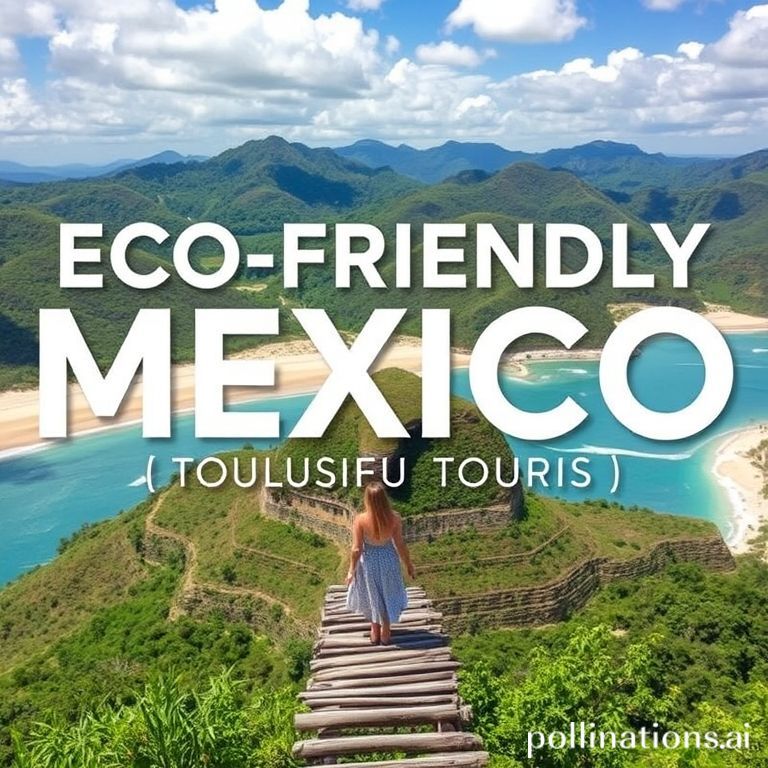Mexico, a land of vibrant culture, breathtaking landscapes, and ancient history, is a dream destination for many travelers. However, the increasing influx of tourists has put a strain on its delicate ecosystems and local communities. Fortunately, a growing movement towards sustainable tourism offers a way to explore Mexico responsibly, ensuring that its beauty and resources are preserved for generations to come. This guide explores the principles and practices of sustainable tourism in Mexico, empowering you to make conscious choices that benefit both the environment and the local people.
Sustainable tourism isn’t just a buzzword; it’s a commitment to traveling in a way that minimizes negative impacts and maximizes positive contributions. It encompasses environmental protection, social responsibility, and economic viability, creating a harmonious balance between tourism and the well-being of the destinations we visit. In Mexico, this means supporting eco-lodges, respecting local traditions, and choosing activities that conserve natural resources.
Understanding Sustainable Tourism
Sustainable tourism aims to minimize the negative impacts of tourism on the environment and local communities while maximizing its positive contributions. This involves several key principles:
- Environmental Protection: Conserving natural resources, reducing pollution, and protecting biodiversity.
- Social Responsibility: Respecting local cultures, supporting community development, and ensuring fair labor practices.
- Economic Viability: Promoting local businesses, creating employment opportunities, and ensuring that tourism benefits the local economy.
Eco-Friendly Accommodations in Mexico
One of the easiest ways to practice sustainable tourism is by choosing eco-friendly accommodations. These establishments prioritize environmental sustainability through various initiatives:
- Eco-Lodges: These lodges are built with sustainable materials, often using renewable energy sources like solar power. They focus on minimizing their environmental footprint and offer nature-based activities.
- Boutique Hotels with Green Practices: Some boutique hotels are adopting sustainable practices, such as water conservation, waste reduction, and using locally sourced products. Look for certifications or labels that indicate their commitment to sustainability.
Examples of Eco-Lodges
- Hotelito Desconocido, Jalisco: This beachfront eco-resort uses solar power and organic farming practices.
- Rancho Margot, Costa Rica (Bordering Mexico): While technically in Costa Rica, it’s a great example of self-sufficient living with sustainable practices, easily accessible if you’re exploring southern Mexico.
Responsible Activities and Tours
Your choice of activities and tours can also significantly impact the environment and local communities. Opt for experiences that promote conservation and support local guides:
- Ecotours: These tours focus on exploring natural areas responsibly, with knowledgeable guides who educate visitors about the local flora and fauna.
- Community-Based Tourism: This type of tourism supports local communities by providing them with economic opportunities and empowering them to preserve their cultural heritage.
- Responsible Wildlife Encounters: Avoid activities that exploit animals or disrupt their natural habitats. Choose reputable tour operators that prioritize animal welfare.
Examples of Sustainable Activities
- Birdwatching in the Yucatan Peninsula: Explore the diverse birdlife of the region with local guides who are passionate about conservation.
- Visiting Mayan Communities: Learn about the Mayan culture and traditions by participating in community-led tours and workshops.
Supporting Local Communities
One of the most rewarding aspects of sustainable tourism is the opportunity to support local communities. By making conscious choices about where you spend your money, you can contribute to their economic well-being and help preserve their cultural heritage:
- Buy Local Products: Support local artisans and businesses by purchasing handmade crafts, souvenirs, and food products.
- Eat at Local Restaurants: Enjoy authentic Mexican cuisine at family-run restaurants and support local farmers by choosing establishments that use locally sourced ingredients.
- Learn the Language: Even a few basic phrases in Spanish can go a long way in showing respect for the local culture and facilitating meaningful interactions with the community.
Travel Tips for Sustainable Tourism in Mexico
Here are some additional tips to help you travel sustainably in Mexico:
- Reduce Your Plastic Consumption: Bring a reusable water bottle, shopping bag, and toiletries to minimize your plastic waste.
- Conserve Water and Energy: Be mindful of your water and energy usage while staying in hotels and accommodations.
- Respect Local Customs: Learn about the local culture and traditions and dress appropriately when visiting religious sites or rural communities.
- Offset Your Carbon Footprint: Consider offsetting your carbon emissions by donating to environmental organizations that support reforestation or renewable energy projects.
Conclusion
Sustainable tourism in Mexico is not just a trend; it’s a necessity. By embracing eco-friendly accommodations, responsible activities, and supporting local communities, you can help preserve the beauty and cultural richness of Mexico for future generations. Make conscious choices, travel with respect, and be a part of the positive change. Your journey can make a difference.
If you enjoyed this article, don’t forget to explore more inspiring stories on Life in Mexico!
IMAGE: A breathtaking view of a lush, green eco-lodge nestled within the Mayan jungle in Mexico. Sunlight filters through the dense canopy, creating dappled light on the sustainable architecture. The lodge is constructed from natural materials like wood and stone, blending seamlessly with the environment. In the foreground, a tourist is seen respectfully observing a local artisan crafting traditional pottery. The mood is peaceful, serene, and emphasizes the harmonious relationship between nature and culture. The style is realistic and vibrant, showcasing the rich colors of the Mexican landscape.


